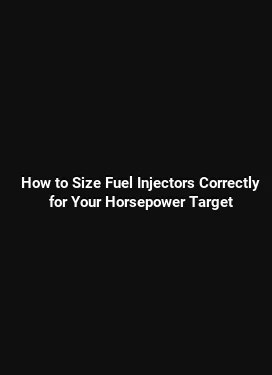How to Upgrade Fuel Pump for E85 Conversion Complete Guide
Converting a vehicle to run on E85 requires thoughtful planning around the intake and fuel systems. A properly upgraded fuel pump plays a central role in delivering consistent flow and maintaining optimal pressure across a broad range of ethanol content. This guide provides a comprehensive, hands-on approach to selecting, installing, and tuning a fuel pump for E85 compatibility. Real-world examples, practical measurements, and step-by-step procedures are included to help enthusiasts achieve reliable performance while protecting the engine and fuel system components.
Critical Considerations for E85 Fuel System Upgrades

E85, with its higher octane rating and different stoichiometric requirements, places distinct demands on the fuel delivery system. The core goal is to maintain stable fuel pressure across fluctuating ethanol percentages, while preserving injector spray patterns and minimizing vapor lock risk. When evaluating the existing setup, paying close attention to pump capacity, hose resistance, line diameter, and the compatibility of seals and elastomers with ethanol are essential steps.
A practical approach begins with establishing baseline flow requirements. Calculate the engine’s torque curve, the expected volumetric efficiency, and the target fuel pressure at wide-open throttle. For naturally aspirated engines, a modest increase in fuel pump head can yield reliability improvements; for turbocharged or supercharged builds, higher flow and a robust return path become critical. It is also important to consider the fuel rail volume and the potential for vapor formation in long lines or cold starts. By mapping these variables, a tailored upgrade path emerges that minimizes risk and supports long-term durability.
System Compatibility and Ethanol Tolerance

Compatibility begins with the pump’s materials and seals. Ethanol of E85 aggressively targets elastomers and certain plastics; selecting components rated for ethanol exposure reduces the risk of leakage and swelling. In addition, wideband oxygen sensors and engine control strategies should align with the ethanol mix to avoid lean or rich excursions, especially during cold starts and transitions between ethanol content levels.
Another practical consideration is the fuel pressure regulator. When converting to E85, some setups benefit from a regulator that offers higher base pressure and improved stability under dynamic loads. The goal is to keep the rail pressure within the injector’s safe operating window while accommodating ethanol’s distinct vaporization characteristics. Testing with a reliable fuel pressure gauge during a hot and cold soak helps verify consistency across operating conditions.
Choosing the Right Fuel Pump for E85
The selection process centers on flow capacity, pressure tolerance, and compatibility with ethanol. Pumps are typically rated by gallons per hour (GPH) or liters per hour (LPH) and by the required pressure head. For E85 conversions, a common target is a pump capable of delivering steady flow at elevated pressure with a safety margin to handle temperature fluctuation and ethanol content variability. Pumps designed for flex-fuel vehicles often incorporate materials and seals suitable for ethanol-rich fuels, which reduces the risk of swelling and seal failure over time.
Key questions to answer when evaluating options include: What is the maximum anticipated fuel pressure at high load? How does the pump respond to sudden throttle changes? What is the pump’s efficiency at partial versus full flow, and how does that affect thermal load? Selecting a pump with proven reliability for ethanol blends, backed by real-world testing data, helps ensure a smoother conversion path.
Determining Flow Requirements for Your Build
To size the pump accurately, begin with the engine’s target power and fuel pressure. A practical method is to calculate peak fuel demand under wide-open throttle, factoring in injector size, injector ramp rates, and the engine’s air-fuel ratio targets at various RPMs. A buffer is essential; many builders select a pump with 15–25 percent more capacity than the peak calculated requirement. This margin accommodates future upgrades, unexpected demand spikes, and aging components that may reduce nominal flow over time.
Fuel line diameter and the allowable pressure drop across fittings influence pump choice as well. If a system exhibits excessive pressure drop due to long, narrow lines or numerous bends, even a high-flow pump may struggle to maintain rail pressure during sustained power demands. In such cases, upgrading line sizes or shortening routing is worth considering as a complementary enhancement to the pump upgrade.
Upgrading the Fuel Pump: Step-by-Step Guide
A successful upgrade follows a structured process: verify compatibility, plan the routing, install with attention to ethanol-rated components, and verify operation through testing. The steps below outline a practical workflow that many enthusiasts have found effective when moving toward E85 readiness.
Step 1: Verify Compatibility and Gather Parts
Before disassembly, confirm that the vehicle’s current fuel system components, including the fuel rail, injectors, regulators, and lines, can work with ethanol-rich fuels. Gather a compatible high-flow pump, ethanol-tolerant seals and hoses, a suitable fuel pressure regulator, a reliable fuel pressure gauge, a wiring harness extension if needed, and fuses rated for the added load. A quality fuel filter designed to capture ethanol-containing contaminants should also be included in the plan.
Label all connections and take photos of the existing setup for reference during reassembly. Creating a clean baseline helps ensure that the upgraded system preserves the intended fuel delivery characteristics and avoids common pitfalls such as air ingestion or improper return routing.
Step 2: Prepare the Mounting and Routing
Select a mounting location that allows for efficient cooling and minimal vibration. For many vehicles, the fuel pump resides inside the tank; upgrading to a pump designed for ethanol often means replacing the existing unit within the same housing or installing an external pump with compatible feed and return lines. Ensure that the mounting bracket and strap hardware are rated for ethanol exposure and resist long-term corrosion.
Route supply and return lines in a way that minimizes sharp bends and potential kinks. Use ethanol-rated rubber or braided hoses with appropriate clamps. Consider adding a fuel line insulation sleeve in regions where temperatures can fluctuate significantly to maintain line integrity and prevent heat-induced pressure changes that could affect performance.
Step 3: Install the Pump and Electrical Connections
With the vehicle safely supported, disconnect the battery and relieve system pressure. Install the new pump, ensuring a secure seal between the pump and the supply line. If an external pump is used, mount it away from heat sources and secure wiring to prevent contact with moving parts or hot surfaces. Connect power and ground with a fused circuit that can handle the pump’s amperage draw. A relay often helps manage current and protect the vehicle’s electrical system.
Check for proper operation by briefly energizing the pump and listening for a consistent hum without abnormal vibration. A quick check for leaks at all connections is essential before proceeding to the permanent mating with the fuel rail and lines.
Step 4: Integrate the Regulator, Rail, and Sensors
Install or adjust the fuel pressure regulator to achieve the desired rail pressure under load. If the system already includes a regulator, verify its compatibility with ethanol and consider upgrading to a regulator rated for higher flow and stability with ethanol blends. Install a high-quality, ethanol-resistant injector O-rings, injector seals, and line clamps to prevent leaks and ensure consistent sealing over time.
Reinstall the fuel rail and ensure that all sensors, including a reliable feed for the engine control unit, remain properly connected. If a wideband O2 sensor or ethanol content monitor is part of the setup, confirm that wiring and sensor placement allow accurate readings across the operating range. Calibration of the engine management system may be necessary to align with the new fuel characteristics.
Step 5: Initial Tuning and Safety Checks
With the physical upgrade complete, perform a cautious initial start and a gradual warm-up. Monitor rail pressure, fuel trims, and injector duty cycles. Look for signs of misfire, lean mixtures, or sudden pressure drops, and be prepared to adjust regulator settings or return line sizing if necessary. Safety-wise, verify that there are no fuel smells, leaks, or pooling under the vehicle during and after operation.
Conduct a controlled test drive that includes a range of RPMs and load conditions. Use a wideband sensor to monitor air-fuel ratio and ensure that the engine remains within the target range across ethanol percentages. If data logging is available, analyze fuel pressure, injector pulse width, and fuel trims to refine the calibration further.
Fuel System Enhancements for Stable Ethanol Delivery
Beyond selecting a capable pump, several complementary improvements contribute to a robust E85-compatible system. Upgrading the fuel filter to a higher-capacity, ethanol-rated variant helps trap contaminants that can be more prevalent in ethanol blends. Reducing potential heat soak by improving line routing and shielding can stabilize rail pressure during high-demand periods. In turbocharged or performance-oriented builds, a return-style fuel system with an adequately sized return line can prevent pressure fluctuations and improve fuel management under boost.
Another critical element is the compatibility of elastomers and seals in contact with ethanol. Choosing hoses, gaskets, and O-rings that withstand ethanol exposure reduces the risk of swelling and leaks that could undermine performance and safety. Regular inspections for signs of wear or degradation are prudent, especially in moisture-prone environments or where ethanol content fluctuates seasonally.
Monitoring and Diagnostics
Implement a monitoring routine that includes periodic checks of fuel pressure, filter condition, and injector performance. Constant monitoring helps detect early signs of system fatigue, such as creeping pressure loss, fluctuating trims, or unusual pump noise. A data-driven approach to maintenance keeps the system reliable while allowing room for future upgrades as performance goals evolve.
Practical Tips for Longevity and Reliability
Longevity hinges on proper material selection, correct sizing, and disciplined maintenance. Ethanol-rich fuels can accelerate certain wear mechanisms if components are marginally sized or poorly selected. Having a slightly oversized pump compared to the calculated maximum demand provides headroom that reduces stress on the pump and minimizes the risk of starvation at high RPM or during rapid acceleration.
Keep fuel temperatures in check by avoiding prolonged exposure to high ambient heat and ensuring adequate cooling around the fuel system components. Regularly inspect clamps, hoses, and connections for signs of cracking or swelling, replacing wear-prone parts preemptively. A clean fuel system, free from contaminants and water, contributes to smoother operation and longer component life.
Cost vs Benefit and Real-World Outcomes
Upgrading the fuel pump for an E85 conversion is a long-term investment that pays dividends in reliability and performance consistency. While initial costs include parts, labor, and potential calibration work, the payoff is a more predictable engine response, improved cold-start behavior, and reduced risk of fuel starvation under high-demand conditions. Communities of hobbyists frequently report that an appropriately matched pump, combined with a tuned fuel system, yields meaningful gains in consistency across ethanol variations and driving scenarios.
In addition to the pump, strategic improvements to the fuel management chain—such as the timing of regulator adjustments, rail capacity, and line sizing—help build a cohesive system that resists performance degradation as ethanol content shifts. The end result is a drivetrain that respects ethanol characteristics while delivering dependable power and drivability across a wide operating envelope.






